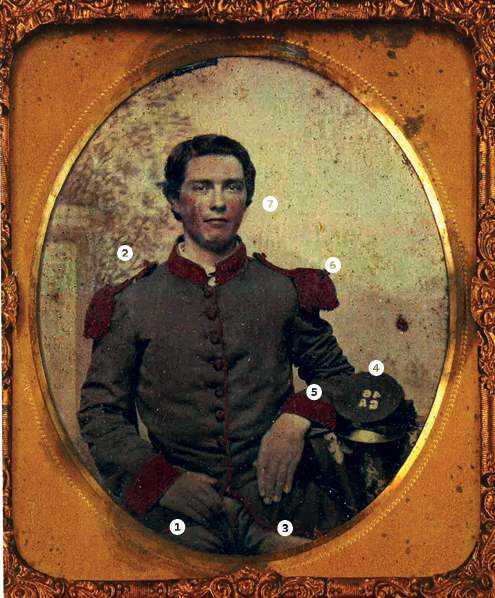Sign up for the Family Tree Newsletter Plus, you’ll receive our 10 Essential Genealogy Research Forms PDF as a special thank you!
Get Your Free Genealogy Forms
"*" indicates required fields
The Civil War did more than divide a nation — it made photographs an integral part of our ancestors’ lives. William Darrah’s Cartes de Visite in Nineteenth-Century Photography (self-published) claims every Civil War soldier had at least one portrait taken — an exaggeration, perhaps, but photography did become a craze. Thousands of photographers sought customers in hometowns and encampments. Men flocked to studios — makeshift or established — to pose in their new uniforms or before a major battle, then proudly sent the images home to relatives anxious for news. Today, some of these portraits are cherished in family collections.
Ambrotypes, paper photographs and tintypes were the images of choice during the war. The picture here is an ambrotype, which is a piece of glass coated with photo chemicals that created a “negative” image, then backed with a darker material to make it appear “positive.”
Ambrotypes (and some tintypes) often were placed in velvet-lined cases with the image, a mat, a glass covering and a strip of brass that held it all together.

- Pat Layton’s relatives preserved this photo throughout the generations, but the soldier’s name has been forgotten. Clues in the photo point to him being an officer in the 46th Georgia Infantry.
- The backdrop features a column and trees, which soften his formal pose. The presence of the backdrop suggests the photo was taken in a studio rather than a makeshift setup at an encampment.
- Images of soldiers, famous folks and families all clamored for attention in homes and albums.
- Atop the cap, the photographer placed white letters and numbers. Zooming in on the photo shows a reversed (remember, ambrotypes are negative images) but clear “46 GA,” indicating this man served with the 46th Georgia Infantry, a regiment formed in March 1862.
- Forget blue and gray: Civil War uniforms are much more colorful than you learned in school. This handsome man paid extra to have the photographer hand-color his uniform to show its red cuffs, trim and epaulets.
- A soldier’s coat and cap were designed to identify the unit he served in. Hashmarks on sleeves, insignia on headgear or shoulder ornamentation tell you his rank and unit. In this case, the epaulets signify he was probably an officer.
- The soldier stares into the distance with a slight smile on his face. His pink-tinged cheeks add vitality. The lack of facial lines suggests he’s young, probably in his late teens or early 20s. Comparing his dark, deep-set eyes, small mouth and narrow chin with facial features shown in other family photos will help the owner identify him.
From the May 2011 issue of Family Tree Magazine
More great genealogy resources from Family Tree Magazine:
ADVERTISEMENT




